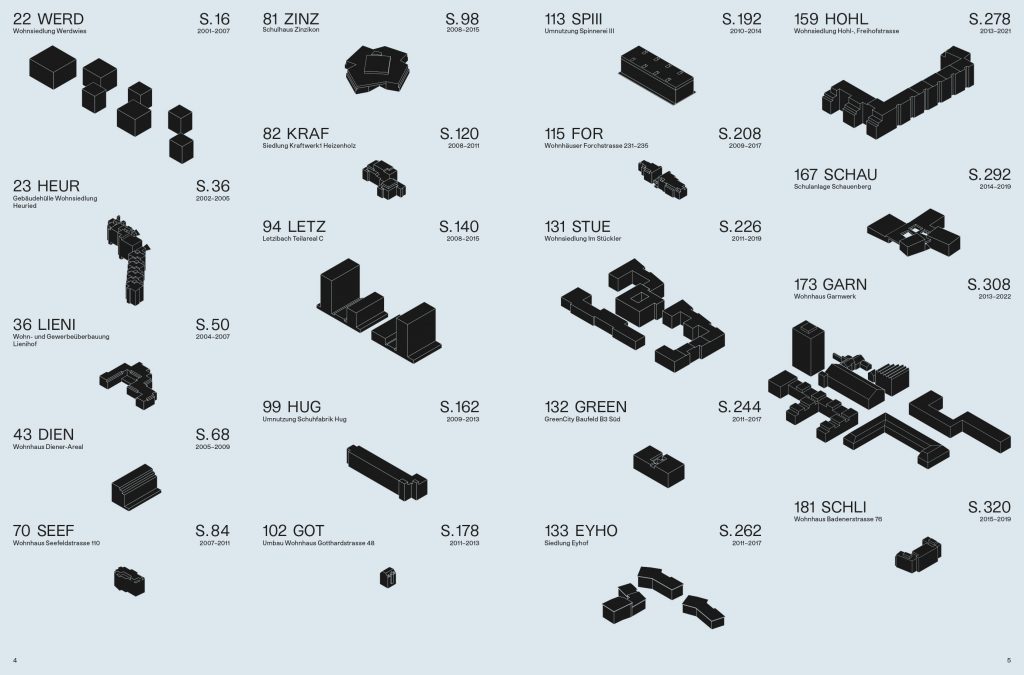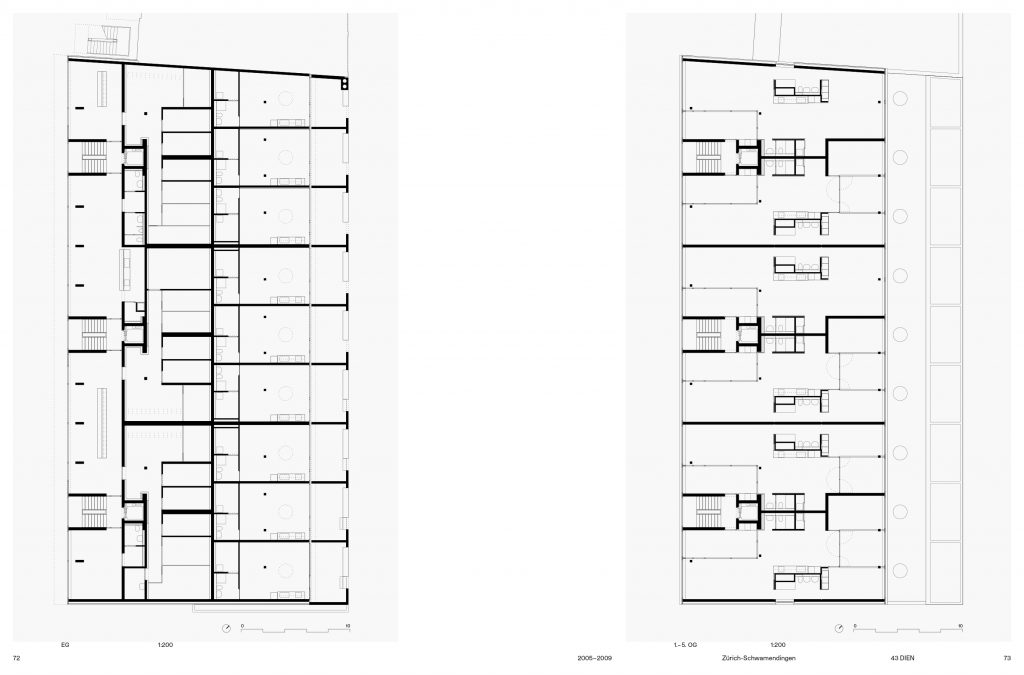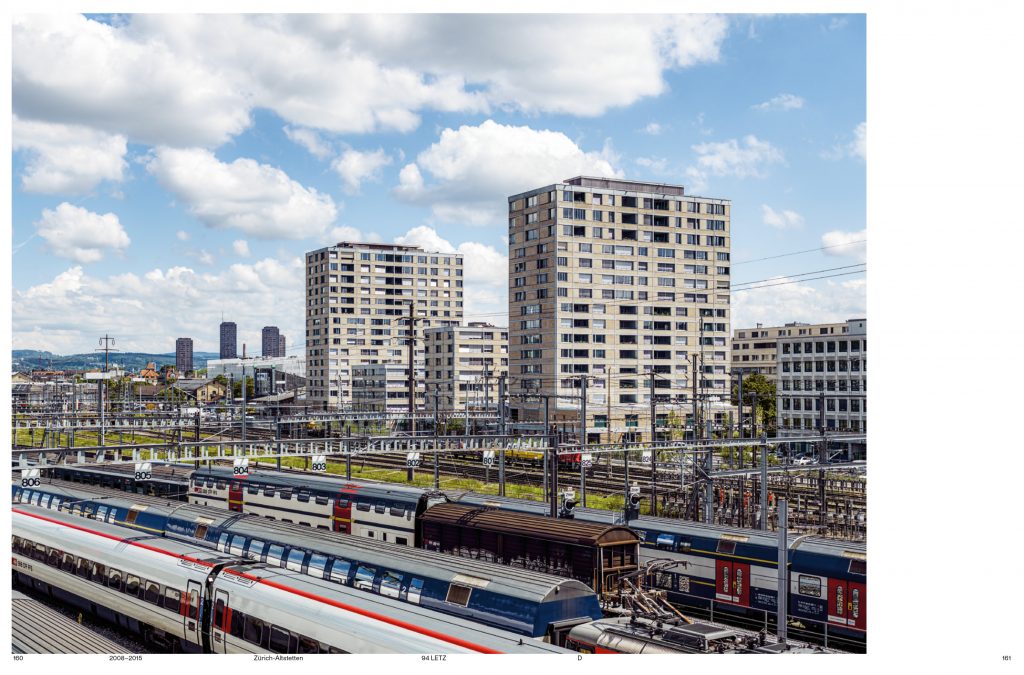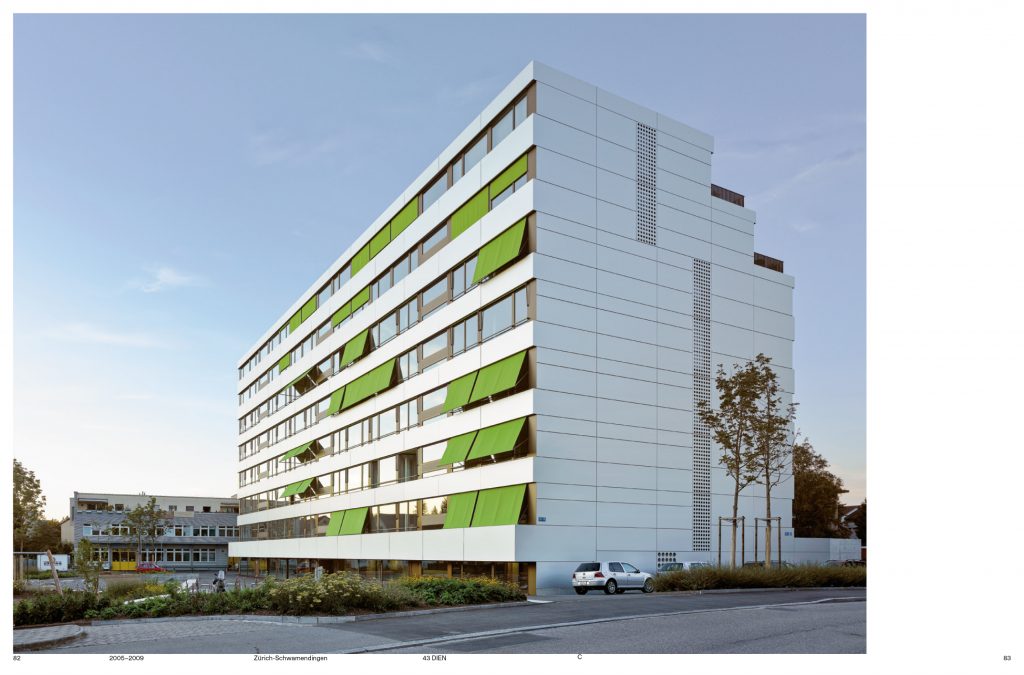***
Title: Adrian Streich Architekten. Bauten + Projekte 2001-2009
Author: Axel Simon
Edited by: Park Books
2020. ISBN: 978-3-03860-135-7
Language: German
451 pages
***
Architecture without rethorics. Alison and Peter Smithson coined this explanation, a statement which over time has become a manifesto. A manifesto aimed at producing an honest, straightforward architecture that, with a reasonable and economical use of the most affordable and simple materials, is capable of responding to social demands by solving problems within a complex and changing urban framework. Just three words, a brief phrase marked in the memory and in the cultural roots of many architects who, in one way or another, feel that we are heirs or intellectual debtors of the British couple. For an architecture without rhetoric, what a marvellous resistance to a discourse that at that time was already obsolete and moribund, the most functionalist hygienism and inconsiderate of the historical heritage of the Charter of Athens. And what a marvellous resistance also to the stylistic, Manichean and futile verbiage of the times that were to come.
Architecture without rethorics. Alison and Peter Smithson acuñaron esta explicación, declaración de intenciones quizá, que con el paso del tiempo se ha convertido en todo un manifiesto. Un manifiesto encaminado a producir una arquitectura honesta, directa, que con un uso razonable y económico de los materiales más asequibles y sencillos sea capaz de responder a demandas sociales resolviendo problemas dentro de un complejo y cambiante marco urbanístico. Tres palabras apenas, una breve frase marcada en la memoria y en las raíces culturales de muchos arquitectos que, de alguna forma u otra, nos sentimos herederos o deudores intelectuales de la pareja británica. Por una arquitectura sin retórica, qué maravillosa resistencia frente a un discurso ya en aquel momento obsoleto y moribundo del higienismo más funcionalista y desconsiderado con la herencia histórica de la Carta de Atenas. Y qué maravillosa resistencia también frente a la verborrea estilística, maniquea y fútil de los tiempos que estaban por venir.

I have no trouble imagining Adrian Streich defending his unwavering adherence to this manifesto for an architecture without rhetoric. With a career spanning a little over two decades, the Swiss architect, whose studio is located in the city centre of Zurich, has made almost every work he has built a small homage to the Smithsons’ manifestation. Among his work there are two types of programmes that stand out in terms of number and research proliferation: schools and, especially, collective housing projects. With a strong interest in the analysis and development of housing typologies, Adrian Streich’s studio has become an obligatory point of reference in the Swiss context. His attitude could be defined as strongly pragmatic. Based on a profound mastery of a multitude of architectural types and the rules that make up their structure and determine their possible evolutions, he develops projects of strong urban impact with a very direct language. In his discourse there are numerous occasions in which he refers to ordinary life, to day-to-day life, as a source of inspiration and a decisive field in which the response of a given architecture is really defined as right or wrong. On the other hand, this approach, far removed from more academic discussions or sterile debates, is complemented by a sensitive attention to detail and choice of materials. The references to the context in which the different projects are developed, as well as to diverse languages such as industrial aesthetics or the elegance of the noveccento milanese, give his works a classical appearance, but at the same time ambiguous in their modernity, which gives them an attractive complexity. An attitude, by the way, that we also find analogous to the way Alison and Peter Smithson operated.
No me cuesta ningún trabajo imaginarme a Adrian Streich defendiendo sin fisuras su adhesión a este manifiesto por una arquitectura sin retórica. Con una trayectoria de algo más de dos décadas, el arquitecto suizo, cuyo estudio se encuentra asentado en el centro de la ciudad de Zürich, ha hecho casi de cada obra construida un pequeño homenaje a la manifestación de los Smithson. Entre su obra encontramos dos tipos de programas que destacan en cuanto a número y proliferación investigadora: los colegios y, especialmente, los proyectos de vivienda colectiva. Con un fuerte interés por el análisis y desarrollo de tipologías habitacionales, el estudio de Adrian Streich se ha convertido en un referente obligado dentro del contexto suizo. Su actitud podría definirse como fuertemente pragmática. En base a un profundo dominio de multitud de tipos arquitectónicos y de las reglas que componen su estructura y determinan sus posibles evoluciones, desarrolla proyectos de fuerte impacto urbano con un lenguaje muy directo. En su discurso son numerosas las ocasiones en que se refiere a la vida cotidiana, al día a día, como fuente de inspiración y campo decisivo en el que realmente la respuesta de una arquitectura determinada se define como acertada o errónea. Por otro lado, este enfoque alejado de discusiones o estériles debates más académicos se complementa con una atención por el detalle y la elección de materiales cargada de sensibilidad. Las referencias al contexto en que los distintos proyectos se desarrollan, así como a lenguajes diversos como la estética industrial o la elegancia del noveccento milanese, dotan a sus obras de una apariencia clásica, pero al mismo tiempo ambigua en su modernidad, que las carga de una atractiva complejidad. Una actitud, por cierto, que encontramos también análoga a la manera de operar de Alison and Peter Smithson.

“Adrian Streich Architekten. Bauten + Projekte 2001-2019” is the first extensive monograph that compiles the work developed to date by Adrian Streich’s studio. The book is published by the Swiss publishing house Park Books, which a priori guarantees excellent quality in terms of editorial criteria or graphic design. In this case, moreover, as we shall try to explain, the book constitutes a channel of communication that is perfectly in tune with the architecture it aims to present. An elegant, yet austere and rigorous character will dominate the presentation of Adrian Streich’s work from the outset. We particularly appreciate the efforts made in the direction of finding the ideal way of matching the books to the content they contain, in the manner of homes that offer comfort and shelter to their guests. Placing the medium at the service of finding the best possible way to explain a given content, in the case of monographs on architecture, seems to us to be a strategy to be celebrated and vindicated.
“Adrian Streich Architekten. Bauten + Projekte 2001-2019” es la primera monografía extensa que recoge la obra desarrollada hasta la fecha por el estudio de Adrian Streich. El libro está editado por la editorial suiza de Park Books, lo que garantiza a priori una excelente calidad en lo que a criterio editorial o diseño gráfico se refiere. En este caso además, como trataremos de explicar, el libro constituye un canal de comunicación en perfecta sintonía con la arquitectura que pretende exponer. Un carácter elegante, pero austero y riguroso dominará desde el principio la presentación del trabajo de Adrian Streich. Valoramos especialmente los esfuerzos realizados en la dirección de encontrar la manera ideal de adecuar los libros al contenido que albergan, a modo de hogares que ofrecen comodidad y refugio a sus huéspedes. Colocar el medio al servicio de encontrar la mejor manera posible de explicar un contenido determinado, en el caso de las monografías sobre arquitectura, nos parece una estrategia que es necesario celebrar y reivindicar.

Throughout its more than 400 pages, Adrian Streich’s most notable works will be presented and exhibited in great detail. We find 17 built works, two of them schools and the rest collective housing projects; and 10 unfinished projects in progress or proposals for competitions. The first thing that stands out in the exhibition of the projects is the rigour maintained in the presentation of each one of them. The different graphic documents, their scales, the way they are drawn, the order in which they are presented, and even the type of models, images or photographs shown are repeated as far as possible from one project to the next, even with urban development projects on a much larger scale. This seems to us to be a remarkable success, as the fact of offering the documentation in such an orderly narrative makes it much easier to study the projects. As we have already said, one of Adrian Streich’s main concerns is the work on typology. The graphic neatness with which each of the projects is drawn is an essential ally to be able to study the typology of the projects in depth and appreciate the value of each of the elements that make them up. There is only one objection to this. In some of the projects, the decision has been taken to present some of the plans on a double page, making it difficult to read parts of them as they are hidden by the binding. This could be considered a minor comment, but being a monograph with a clear instrumental vocation, a virtue that we particularly seek as practicioners, we believe it should have been avoided. We like to consider architectural books as working tools, especially monographs or typological compendiums.
A lo largo de sus más de 400 páginas, las obras más notables de Adrian Streich serán presentadas y expuestas con gran detalle. Nos encontramos con 17 obras construidas, dos de ellas colegios y el resto proyectos de vivienda colectiva; y 10 proyectos en curso no concluidos o propuestas de concursos. Lo primero que llama la atención en la exposición de los proyectos es el rigor mantenido a la hora de presentar cada uno de ellos. Los distintos documentos gráficos, sus escalas, la manera de dibujar, el orden con que se presentan, o incluso el tipo de maquetas, imágenes o fotografías que se muestran se repite en la medida de lo posible de un proyecto a otro, incluso con proyectos de desarrollos urbanos que presentan una escala mucho mayor. Esto nos parece un acierto muy notable, ya que el hecho de ofrecer la documentación de una forma tan ordenada facilita mucho el estudio de los proyectos. Como ya hemos dicho, una de las preocupaciones fundamentales de Adrian Streich es el trabajo sobre la tipología. La pulcritud gráfica con que se dibujan cada uno de los proyectos es una aliada esencial para poder profundizar en el estudio tipológico de los proyectos y apreciar el valor de cada una de los elementos que los componen. En relación a este tema solo podemos encontrar una objeción. En alguno de los proyectos se ha tomado la decisión de presentar alguna de las plantas a doble página, dificultando por ello la correcta lectura de partes de la misma al quedar ocultas por el plirgoo de encuadernación. Esto podría ser considerado como un comentario menor, pero tratándose de una monografía con una clara vocación instrumental, virtud que particularmente nosotros buscamos como arquitectos en práctica, creemos que debería haberse evitado. Nos gusta considerar los libros de arquitectura como herramientas de trabajo, especialmente las monografías o compendios tipológicos.
In addition to the graphic documentation that defines each of the projects, they are explained succinctly in brief abstracts. It is evident from the beginning that the book, just as the architect does in his daily practice, seeks to distance itself as far as possible from academic rhetoric, and therefore does not seek to accompany this collection of works with dense texts or theoretical speculations on the projects. The book opens with a brief interview with Adrian Streich, whose colloquial tone stands out positively, and closes with a slightly longer text that aims to build a critical framework around the work of the Swiss architect.
Más allá de la documentación gráfica que define cada uno de los proyectos, éstos son explicados de manera escueta en breves memorias. Es evidente desde el comienzo que el libro, así como lo hace el arquitecto en su praxis diaria, busca alejarse lo máximo posible de una retórica académica, y por ello no persigue acompañar esta colección de obras con textos densos o especulaciones teóricas de los proyectos. Abrirá el libro una breve entrevista con Adrian Streich, cuyo tono coloquial destaca positivivamente, y como cierre encontraremos un texto ligeramente más extenso que, ahora así, pretende construir un marco crítico alrededor de la obra del arquitecto suizo.

It is in relation to the nature of these texts, or rather their ability to communicate, that our main criticism of “Adrian Streich Architekten” arises. We found the decision to publish a work of this level only in German surprising, making it difficult for all those who do not know the language to approach its valuable content. This is particularly striking given the brevity of the texts and the minor importance they have in the book as a whole compared to the graphic documents. Assuming the ease with which this issue could have been resolved, perhaps by adding a short appendix at the end with an English translation in order to respect the main discourse and editorial idea of the book, we think that the decision to publish only in German may be due to a personal wish of the architect. Without knowing the reasons for this, and without wishing to speculate too much here on the cultural implications, it seems to us to be a major mistake not to promote the dissemination of knowledge as much as possible. Adrian Streich’s work is little known outside Switzerland, and it would undoubtedly have been positive to promote the dissemination of a highly valuable architectural practice. Some of his projects for housing cooperatives, or the Schauenberg school, for example, are fundamental reference works.
Es en relación a la naturaleza de estos textos, o mejor dicho, a su capacidad de comunicar, donde surge nuestra principal crítica a “ Adrian Streich Architekten”. Hemos encontrado sorprendente la decisión de publicar una obra de este nivel sólo en alemán, dificultando así que todas aquellas personas que no conocen el idioma puedan acercarse a su valioso contenido. Esto llama la atención especialmente dada la brevedad de los textos y la escasa importancia que tienen en el conjunto global del libro frente a los documentos gráficos. Asumiendo la facilidad con que podría haberse resuelto este asunto, añadiendo quizá un breve anexo al final con una traducción al inglés para respetar el hilo conductor y la idea editorial del libro, pensamos que la decisión de publicarse sólo en alemán pueda responder a un deseo personal del arquitecto. Desconociendo los motivos de esto, y no queriendo especular aquí en exceso sobre las implicaciones culturales que esto conlleva, nos parece un error importante no favorecer la difusión del conocimiento lo máximo posible. La obra de Adrian Streich es muy poco conocida fuera de Suiza, e indudablemente habría sido positivo favorecer la difusión de una práctica arquitectónica de gran valor. Algunos de sus proyectos para cooperativas de viviendas, o la escuela de Schauenberg, por ejemplo, son obras de referencia fundamentales.
In conclusion, despite the problem that it is only published in German, “Adrian Streich Architekten” is a notable and necessary example of how a monograph should be written and edited in the service of the work being presented. As has already happened with other books presented in this series, this one can be considered as a reference work for those interested in the typological study of collective housing, focusing in this case on the work of an office that must be known and valued as essential in current practice.
Como conclusión, a pesar del problema que puede ser que se encuentre sólo publicado en alemán, “Adrian Streich Architekten” constituye un ejemplo notable y necesario de cómo se tiene que hacer una monografía al servicio de la obra que se expone. Como ya ha sucedido con algún otro libro presentado en esta serie, éste puede ser considerado como una obra de referencia para aquellos interesados en el estudio tipológico de vivienda colectiva, centrándose en este caso en la obra de una oficina que es necesario conocer y valorar como imprescindible en la práctica actual.
